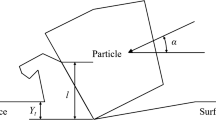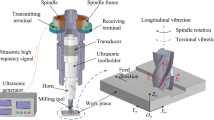Abstract
Advances in machining technology, particularly in the field of micro-machining, have led to the design and creation of miniature components suitable for use in the precision engineering industry. However, the need to contain ubiquitous burrs still exists and has to be addressed. Previous studies on deburring have mostly focused on the parametric investigations of orientation, temperature, type of liquid media and abrasives, frequency, deburring time and power. It is hypothesized that by inducing compressive residual stresses on a pre-machined workpiece surface, the resulting burrs caused by machining can be minimized or even eliminated. The paper presents the findings of an investigative study into the possibility of inducing compressive residual stresses on machined surfaces by the use of ultrasonic cavitation, with the aim of reducing or eliminating burr formation. The paper also briefly reviews the development of ultrasonic cavitation and covers published work on deburring by ultrasonic cavitation. Experimental results are presented on the performance of ultrasonic cavitation peening on the residual stress in Stavax stainless steels and on micro-burr formation.
Similar content being viewed by others
References
Rozenberg LD (1973) Physical principles of ultrasonic technology, vol 1. Plenum Press, New York, USA
Yeo SH, Ngoi BKA, Chua LY (1997) Ultrasonic deburring. Int J Adv Manuf Technol 13(5):333–341
Lee KS, Kanno S (2001) Deburring by ultrasonic vibration. 1st Asia-Pacific Forum on Precision Surface Finishing and Deburring Technology, Singapore, pp 119–126
Choi HZ, Kang EG, Lee SW, Ko SL (2002) Micro deburring using ultrasonic vibration. 2nd Asia-Pacific Forum on Precision Surface Finishing and Deburring Technology, Seoul, Korea, pp 151–157
Choi HZ, Lee SW, Choi YJ, Ko SL (2003) A study on deburring technology using ultrasonic cavitation. 3rd Asia-Pacific Forum on Precision Surface Finishing and Deburring Technology, Melbourne, Australia, pp 10
Enomoto S, Ioi T, Kato K, Zhou L, Liu X (2002) Burr reduction with a fine-scrape cutter. J Mater Process Technol 124(1–2):255–258
Ko SL, Chang JE, Yang GE (2003) Burr minimizing scheme in drilling. J Mater Process Technol 140:237–242
Balasubramaniam R, Krishnan J, Ramakrishnan N (1999) An experimental study on the abrasive jet deburring of cross-drilled holes. J Mater Process Technol 91(1–3):178–182
Leong KF, Chua CK, Chua GS, Tan CH (1998) Abrasive jet deburring of jewellery models built by Stereolithography Apparatus (SLA). J Mater Process Technol 83:36–47
Balasubramaniam R, Krishnan J, Ramakrishnan N (2002) A study on the shape of the surface generated by abrasive jet machining. J Mater Process Technol 121:102–106
Balasubramaniam R, Krishnan J, Ramakrishnan N (1998) Investigation of AJM for deburring. J Mater Process Technol 79:52–58
Choi IH, Kim JD (1998) Electrochemical deburring system using electroplated CBN wheels. Int J Mach Tools Manuf 38(1–2):29–40
Choi IH, Kim JD (1998) A study of the characteristics of the electrochemical deburring of a governor-shaft cross hole. J Mater Process Technol 75:198–203
Lee SH, Dornfeld DA (2001) Precision laser deburring and acoustic emission feedback. Trans ASME, J Manuf Sci Eng 123(1):356–364
Lee SH, Dornfeld DA (2001) Precision laser deburring. Trans ASME, J Manuf Sci Eng 123(4):601–608
Kanno S, Lee KS, Ding X (2003) Improvement of edge and corner quality of machined components. 3rd Asia-Pacific Forum on Precision Surface Finishing and Deburring Technology, Melbourne, Australia, pp 98–108
Soyama H, Kusaka T, Saka M (2001) Peening by the use of cavitation impacts for the improvement of fatigue strength. J Mater Sci Lett 20:1263–1265
Mathias M, Gocke A, Pohl M (1991) The residual stress, texture and surface changes in steel induced by cavitation. Wear 150:11–20
Soyama H, Saito K, Saka M (2002) Improvement of fatigue strength of aluminium alloy by cavitation shotless peening. Trans ASME, J Eng Mater Technol 124:135–139
Wang S, Li Y, Yao M, Wang R (1998) Compressive residual stress introduced by shot peening. J Mater Process Technol 73:64–73
Krause H, Mathias M (1987) Investigation of cavitation erosion using X-Ray residual stress analysis. Wear 119:343–352
Abramov VO, Abramov OV, Sommer F, Gradov OM, Smirnov OM (1998) Surface hardening of metals by ultrasonically accelerated small metal balls. Ultrasonics 36:1013–1019
Odhiambo D, Soyama H (2003) Cavitation shotless peening for improvement of fatigue strength of carbonized steel. Int J Fatigue 25(9–11):1217–1222
Soyama H, Park JD, Saka M (2000) Use of cavitating jet for introducing compressive residual stress. Trans ASME, J Manuf Sci Eng 122(1):83–89
Al-Obaid YF (1990) A rudimentary analysis of improving fatigue life of metals by shot peening. Trans ASME, J App Mech 57:307–312
Busnaina AA, Kashkoush II, Gale GW (1995) An experimental study of megasonic cleaning of silicon wafers. J Electrochem Soc 142(8):2812–2817
Author information
Authors and Affiliations
Corresponding author
Rights and permissions
About this article
Cite this article
Toh, C.K. The use of ultrasonic cavitation peening to improve micro-burr-free surfaces. Int J Adv Manuf Technol 31, 688–693 (2007). https://doi.org/10.1007/s00170-005-0249-9
Received:
Accepted:
Published:
Issue Date:
DOI: https://doi.org/10.1007/s00170-005-0249-9




